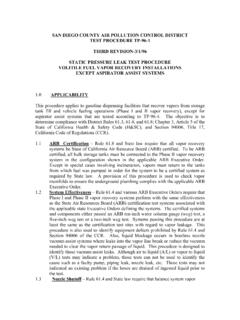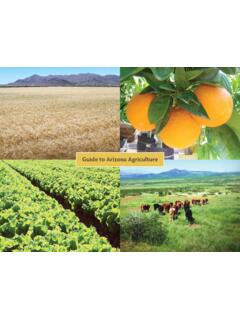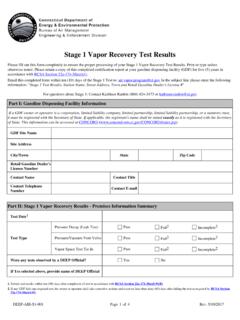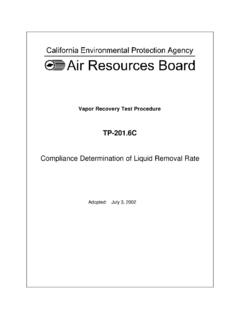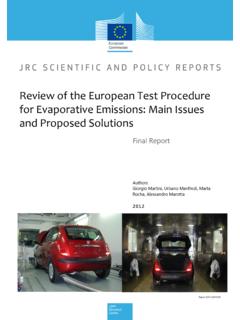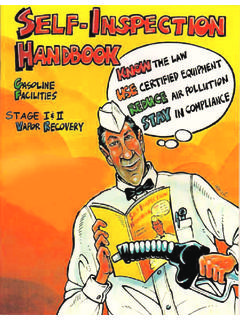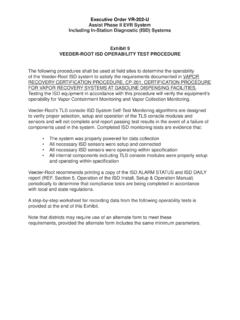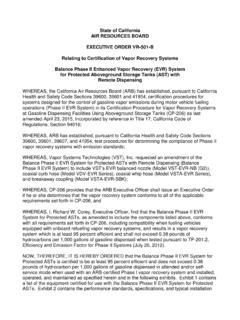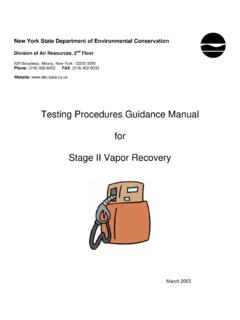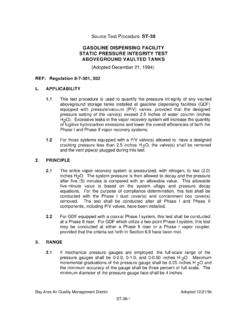Transcription of Test Method: 1996-04-12 TP-201.5 Determination (by Volume ...
1 vapor recovery Test Procedure Determination (by Volume Meter) of Air to Liquid Volume Ratio of vapor recovery Systems of Dispensing Facilities Adopted: April 12, 1996 April 12, 1996 page 1 California Environmental Protection Agency Air Resources Board vapor recovery Test Procedure Determination (by Volume Meter) of Air to Liquid Volume Ratio of vapor recovery Systems of Dispensing Facilities 1 APPLICABILITY Definitions common to all certification and test procedures are in: D-200 Definitions for Certification procedures and Test procedures for vapor recovery Systems For the purpose of this procedure, the term "ARB" refers to the State of California Air Resources Board, and the term "ARB Executive Officer" refers to the Executive Officer of the ARB or his or her authorized representative or designate.
2 This test procedure can be used to quantify the air to liquid Volume ratio (A/L) of a vapor recovery system. This test procedure is particularly well suited to dispensing facility vapor recovery systems which use bootless nozzles with circumferential holes near the front of their spouts; but it may be adapted for other systems. This test procedure can be used to determine the performance specification for air to liquid Volume ratio of a vapor recovery system during the certification process and subsequently to determine compliance with that performance specification for any installations of such a system.
3 When this test procedure is used to set a performance specification for a system, any deviations from the use of the equipment and procedures specified below shall be written into the certification report for such system if it is certified. Any compliance testing of a system shall be done according to this procedure, with appropriate adjustments for such deviations. 2 PRINCIPLE AND SUMMARY OF TEST PROCEDURE The air to liquid Volume ratio (A/L) of a vapor recovery system is, for a given dispensing episode, the quotient of the Volume of air collected by a nozzle and the April 12, 1996 page 2 Volume of liquid dispensed by that nozzle.
4 In principle, any equipment and procedure which provides for the simultaneous measurement of air Volume collected and liquid Volume dispensed, from the same system, is a basis for Determination of A/L for that system. measures A/L rather than the Volume ratio of vapor (mixed with air) to liquid (V/L), because doing so is much more consistent, repeatable, and less expensive. A/L testing can be coordinated with efficiency testing to yield A/L performance specifications for compliance testing. 3 BIASES AND INTERFERENCES There are no known biases or interferences inherent to the equipment and procedures specified; however several system parameters must be monitored and controlled so that this procedure can serve its intened purpose.
5 Non-Repeatable or Non-Representative Test Conditions It is possible that system components could operate during testing in such a way that results are non-repeatable or are non-representative of subsequent installations of the system. To minimize such effects, the ARB test monitor shall note any relevant operating parameters for inclusion in the certification process as conditions on certification at a particular A/L ratio. Non-Repeatable Test Conditions For example, the liquid dispensing rate can introduce bias if it is non-repeatable; for many systems, the A/L performance varies with liquid flow rate.
6 In the procedures below, a maximum repeatable flow rate of liquid is required. If A/L performance varies with liquid flow rate for some system, it is necessary to place an upper limit on liquid flow rate in the ARB Executive Order. (1) (Liquid) Fuel Pumps To achieve repeatability, it is necessary to control the number of simultaneous dispensing episodes from a common liquid pump during certification testing. Such number shall be a performance specification in the ARB Executive Order so that subsequent installations of the system can be consistently tested. (2) (Air and vapor ) Assist Pumps To achieve repeatability, it is necessary to control the number of simultaneous dispensing episodes served by a common assist pump during certification testing.
7 Such number shall be a performance April 12, 1996 page 3 specification in the ARB Executive Order so that subsequent installations of the system can be consistently tested. Non-Representative Test Conditions For example, nozzle quantities, qualities, and interactions can introduce bias if they are non-representative; for many systems, the A/L performance varies with such parameters. In the procedures below, if more than one nozzle is served by the same assist pump, precautions are required to eliminate nozzle interactions which yield non-representative A/L performance. Within a system subject to certification testing, nozzle qualities must be representative of the nozzle qualities within subsequent installations.
8 To achieve representativeness, it may be necessary to control the nozzle quantities, qualities, and interactions during certification testing and subsequently by inclusion of specific requirements in the ARB Executive Order. Condensation, Evaporation, and Other Factors Different systems have different tendencies to condense and evaporate liquid in vapor lines. This and other factors can cause different A/L values in different modes of system operation. In consideration of such factors, the ARB Executive Officer may determine a different data collection protocol and a different data reduction protocol than the examples given in 8 and 11.
9 4 SENSITIVITY, RANGE, AND PRECISION The values of the determinations required by this test procedure are well within the limits of sensitivity, range, and precision of the specified equipment. 5 EQUIPMENT Some of the equipment for testing a bootless nozzle is shown in: Figure 1 A/L Volumetric Test Meter and Figure 2 A/L Test Tank. April 12, 1996 page 4 Air Volume Meter and Plumbing Hardware The plumbing hardware shall connect the nozzle spout to a positive displacement air Volume meter ( Roots meter) so that the air Volume pulled into the collection holes in the spout can be measured with minimal pressure drop.
10 Use a calibrated positive displacement gas Volume meter ( a Roots meter) for measurement of volumetric flow rate through the sleeve. Use rotary type positive displacement meter(s) with a back pressure limit (BPL) less than: inches water column at a flowrate of 3,000 CFH down to inches water column at a flowrate of 30 CFH for a meter with a rating over 1000 CFH and inches water column at a flowrate of 800 CFH down to inches water column at a flowrate of 16 CFH for a meter with a rating of or under 1000 CFH. Meter(s) shall be equipped with taps accomodating the following equipment: (1) taps on the inlet side for (a) a thermocouple with a range of 0 to 150 oF and (b) a pressure gauge with a range providing absolute pressure readings within 10 to 90% of the range (more than one gauge shall be used, if necessary) and (2) taps on the inlet and outlet sides for a differential pressure gauge with a range of 0 to < 2x BPL ( full scale shall be less than twice the back pressure limit) or any other range appropriate to allow detection of a pressure drop greater than the BPL.
